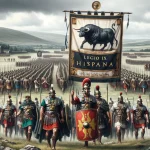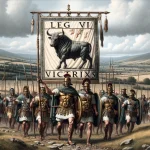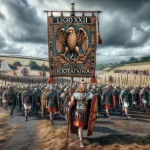Caesar’s Legions
The Roman legions that set sail across the Channel under Caesar’s command were hardened veterans of the Gallic Wars, skilled in the art of war and disciplined in the tactics that had conquered much of the known Western world. These soldiers were the cogs of Rome’s military machine, their shields and glinting helmets an omen of the empire’s reach and ambition.
For the first invasion in 55 BC, Caesar initially took two legions, the Seventh (Legio VII) and the Tenth (Legio X). The exact nomenclature of these legions at the time may not have included the epithets by which they were later known, but these designations help to identify them. The Seventh Legion is sometimes referred to as Legio VII Claudia, but it’s unclear if it had this title during the invasion of Britain.
During the second invasion in 54 BC, Caesar returned with a much larger force, traditionally reported to include five legions and 2,000 cavalry. The legions that participated in this second expedition likely included those from his earlier campaign plus additional forces. However, the specific names and numbers of the legions that accompanied him are not detailed in the same way as in later Roman military records.
Claudius’s Legions’ Invasion of Britain
In 43CE Claudius’s conquest of Britain had begun. An Army of four legions with auxiliary troops, amounting to 40,000 men had been assembled at Boulogne, and a fifth was in reserve. The Legions were the XIV Gemina, II Augusta, IX Hispana, and XX Valeria Victrix.
Legion Movements During the Roman Occupation of Britain
XIV Gemina was withdrawn from Britain in 67AD by Nero for a campaign in the east. The II Adiutrix legion was formed in 70AD by the emperor Vespasian and dispatched to Britain almost immediately with the new Governor Celialis to conquer Brigantes.
The Legio VI Victrix was in Britain by 122AD, at the time of Emperor Hadrian’s visit. They had come to replace the diminished IX Hispana at Eboracum (York).
There is evidence that a vexillation from Legio XXII Primigenia was sent to Britain in the early third century.
The is Epigraphic Evidence that a primus pilus of the Twenty-Second Legion Deiotariana, became the prefect of the Twentieth Legion Valeria Victrix and some point before before A.D. 161.
Notes on Roman legions
In the days of the Republic, a legion was recruited by an army commander after he had been given a task by the Senate, whether to conquer a new province or hold an old one. When the task was completed, the legion – a collection of volunteers, all who should be Roman citizens – should have disbanded.
During the last of the Civil Wars, the three Triumvirs each raised their own army, as did the pirate chief Sextus Pompeius. Augustus Caesar persuaded Lepidus’s 14 legions (and the 8 that joined Lepidus after Pompeius had abandoned them) to desert to him, after which he engaged and defeated Marcus Antonius. The battle of Actium, in 31 B.C., left Augustus the undisputed master of Rome and her empire, but also left him with more than 50 legions, far too many for the peaceful era that was to come.
Augustus completely reorganised the Roman forces. Instead of temporary volunteers, there was to be a standing army. By disbanding some and merging others, he ended up with a new force of 28 legions. Most of these were to last for more than two centuries, more than half for four, and one – the V Macedonia – was still to be found in the sixth century A.D.
- I Germanica
- II Augusta
- III Augusta
- III Gallicia
- III Cyrenaica
- IV Macedonia
- IV Scythica
- V Alaudae
- V Macedonia
- VI Victrix
- VI Ferrata
- VII Macedonia (became the Claudia Pia Fidelis)
- VIII Augusta
- IX Hispania
- X Gemina
- X Fretensis
- XI Claudia Pia Fidelis
- XII Fulminata
- XIII Gemina
- XIV Gemina Martia Victrix
- XV Apollinaris
- XVI Gallica
- XVII
- XVIII
- XIX
- XX Valeria Victrix
- XXI Rapax
- XXII Deiotariana
The 6 legions with duplicate numbers show that at least some numbers were retained from the original armies – all three 3rd legions were retained. Equally, it is clear that some numbers must have been allocated anew, otherwise the neat sequence to 22 would not have happened.
The legions’ names have varying origins. The legions with duplicated numbers presumably bear names indicating which army they came from. The legions Augusta were presumably from his own army, and perhaps distinguished themselves in some way at some time, while the V Alaudae were recruited from Gallic provincials by Julius Caesar. The three legions Gemina were amalgamations of two or more of the pre-Actium legions. Suetonius mentions that Augustus once disbanded a Tenth legion, but perhaps they were actually amalgamated. It is clear that some of the legions were unnamed at their creation; the XVII, XVIII, and XIX never gained a name before they were lost in the Tuetoburg Wald in 9 A.D., and the VII and XI gained their names (“the Loyal Claudians”) after they refused to rebel in 42 A.D., though the VII had a previous name. But some names are totally obscure.
The Julio-Claudian Emperors
The loss of three legions near the end of Augustus’ reign brought the army down to 25 legions. Only two of the subsequent Julio-Claudian emperors were to do anything about this, but by the end of Nero’s reign in 68 A.D., the strength was back to 28 legions again:
- Claudius 43 A.D. XV Primigenia
- Claudius 43 A.D. XXII Primigenia
- Nero 67 A.D. I Italica
There is some dispute about whether Caligula or Claudius raised the first two, but the latter is more likely, as 4 legions were about to be taken to the invasion of Britain (II Augusta, IX Hispania, XIV Gemina, and XX Valeria Victrix), and some replacements would be necessary.
The Flavian reforms
In 68 A.D. the Senate declared Nero a public enemy, and appointed Galba to the Imperium, probably the last significant political action they were ever to take. Galba took his own legion from Spain, raised a second – the VII Galbiana – and marched on Rome. Various other commanders opposed him, and the resulting wars produced four emperors within the same year – 69 A.D. – with the eventual triumph of Vespasian, founder of the Flavian dynasty.
After such a great conflict, it was clear that some legions could no longer be trusted, and others needed to be raised to replace them. The Flavian reforms of 70 A.D. were probably the greatest changes to be made to the Roman army since the Augustan reorganisation.
- I Adiutrix
- II Adiutrix
and two others
- I Germanica
- VII Galbiana
were merged to form the new VII Gemina.
Finally, two other legions, supporters of Vespasian from the start, gained new names.
| was | became | |
 | Macedonia | Flavia Felix |
 | Gallica | Flavia Firma |
The middle empire
Over the next 140 years, 4 legions were to be lost in wars, and 8 raised to replace them or otherwise strengthen the army for specific campaigns.
- Raised 83A.D. Domitian I Minervia
- Lost 87A.D. [Domitian] V Alaudae
- Lost 92A.D. [Domitian] XXI Rapax
- Raised 102A.D. Trajan II Trajana
- Raised 102A.D. Trajan XXX Ulpia Victrix
- Lost in Judea 132A.D. [Hadrian] IX Hispania
- Lost 135A.D. [Hadrian] XXII Deiotariana
- Raised 165A.D. Marcus Aurelius II Pia Italica
- Raised 165A.D. Marcus Aurelius III Concors Italica
- Raised 197A.D. Septimus Severus I Parthica
- Raised 197A.D. Septimus Severus II Parthica
- Raised 197A.D. Septimus Severus III Parthica
Including the three raised for the Parthian wars, Rome had 33 legions defending its territories. In 215 A.D., these were occupying postings around the various provinces as follows (the date of posting is shown where known).
- I Adiutrix Lower Pannonia
- I Italica Lower Moesia
- I Minervia Lower Germany
- I Parthica Mesopotamia
- II Adiutrix Lower Pannonia 90
- II Augusta Upper Britain (Caerleon) 43
- II Parthica Italy 197
- II Pia Italica Noricum 176
- II Trajana Egypt
- III Augusta Numidia by Augustus
- III Concors Italica Raetia
- III Cyrenaica Arabia
- III Gallicia Syria Phoenice
- III Parthica Mesopotamia
- IV Flavia Felix Upper Moesia
- IV Scythica Syria Coele
- V Macedonia Upper Dacia
- VI Ferrata Syria Palaestina
- VI Victrix Lower Britain (York) 122
- VII Claudia Pia Fidelis Upper Moesia
- VII Gemina Nearer Spain
- VIII Augusta Upper Germany
- X Fretensis Syria Palaestina
- X Gemina Upper Pannonia before 130
- XI Claudia Pia Fidelis Lower Moesia
- XII Fulminata Cappadocia
- XIII Gemina Upper Dacia
- XIV Gemina Martia Victrix Upper Pannonia
- XV Apollinaris Cappadocia 114
- XVI Flavia Firma Syria Coele
- XX Valeria Victrix Upper Britain (Chester) 43
- XXII Primigenia Upper Germany before 130
- XXX Ulpia Victrix Lower Germany
Note that “Upper” and “Lower” were political designations, so Upper Britain, for example, was the southern half of the island and Lower Britain the northern half.
The Notitia Dignitatem
The situation in 215 was probably the heyday of the classical legion. Over the next 200 years, many more were to be lost in battle, or just to be disbanded or fade away. The tide of warfare was turning away from the classical infantry battle, and towards cavalry warfare between bands of mercenaries fighting for Rome – so long as she paid – on the one hand, and rebels and barbarians on the other. The traditional legions became the garrison troops, settled in a province, with retired legionaries marrying local women and their sons and grandsons enlisting in their turn.
In such a situation, it would be rare for a legion to move posting, and indeed the record shows none doing so. In 395 A.D., the Notitia Dignitatem (a record of all the appointments in the empire) shows only 24 legions remaining, all unmoved for 180 years.
- I Adiutrix Lower Pannonia
- I Italica Lower Moesia
- I Parthica Mesopotamia
- II Adiutrix Lower Pannonia
- II Parthica Italy
- II Pia Italica Noricum
- II Trajana Egypt
- III Concors Italica Raetia
- III Cyrenaica Arabia
- III Gallicia Syria Phoenice
- IV Flavia Felix Upper Moesia
- IV Scythica Syria Coele
- V Macedonia Upper Dacia
- VI Victrix Lower Britain (withdrawn in 406)
- VII Claudia Pia Fidelis Upper Moesia
- VII Gemina Nearer Spain
- X Fretensis Syria Palaestina
- X Gemina Upper Pannonia
- XI Claudia Pia Fidelis Lower Moesia
- XII Fulminata Cappadocia
- XIII Gemina Upper Dacia
- XIV Gemina Martia Victrix Upper Pannonia
- XV Apollinaris Cappadocia
- XVI Flavia Firma Syria Coele











